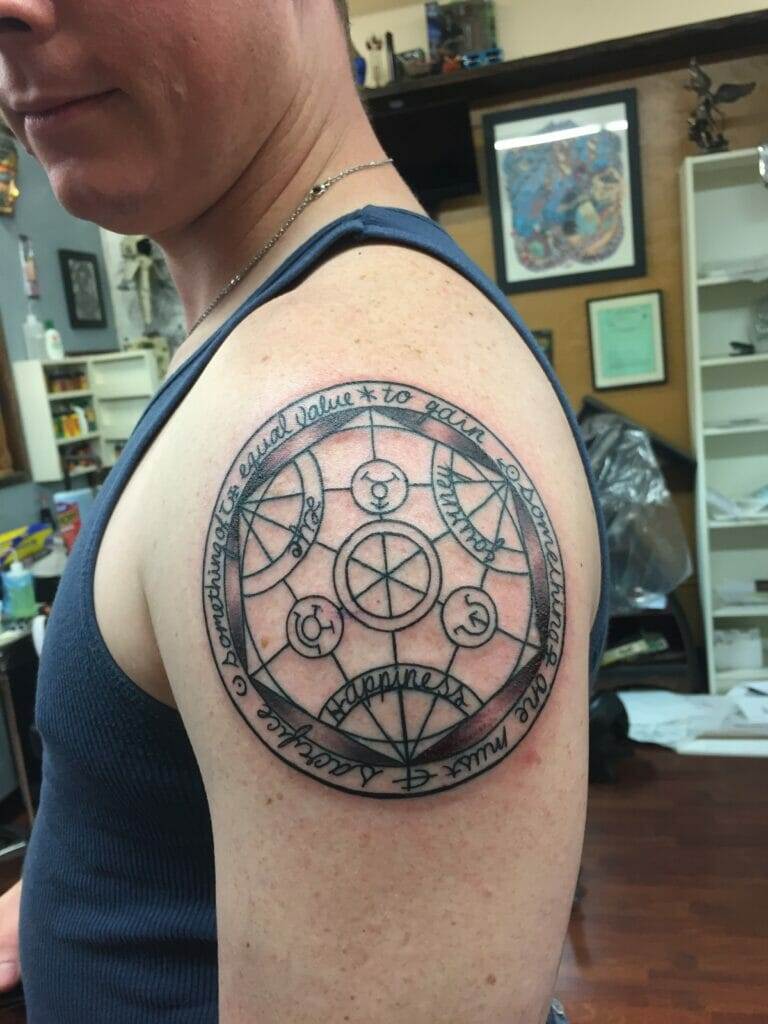
Portrait tattoos are a beautiful and meaningful form of body art that have been popular for centuries. They allow individuals to permanently commemorate loved ones, idols, or even themselves on their skin. The artistry and skill required to create realistic and detailed portrait tattoos is truly remarkable. In this article, we will explore the history of portrait tattoos, the techniques used to capture likeness, the importance of communication with clients, the role of emotion in capturing the spirit of the subject, the impact of color, the challenges faced by tattoo artists, the use of technology in enhancing portrait tattoos, current trends and innovations in the art form, and the personal connection between artist and client.
The History of Portrait Tattoos: From Ancient Times to Modern Day
The origins of portrait tattoos can be traced back to ancient cultures such as Egypt and Rome. In these civilizations, tattoos were often used to symbolize status or religious beliefs. Portraits were a way for individuals to honor their loved ones or commemorate important events. These early portrait tattoos were often simple and stylized, but they laid the foundation for the art form we know today.
Throughout history, portrait tattoos have evolved alongside advancements in tattooing techniques and technology. In the 18th and 19th centuries, portrait tattoos became more detailed and realistic thanks to improvements in tattooing equipment and ink pigments. However, it wasn’t until the 20th century that portrait tattoos truly gained popularity. With the rise of tattoo culture and the development of new tattooing techniques, artists were able to create incredibly lifelike portraits on their clients’ skin.
Today, portrait tattoos are more popular than ever. People from all walks of life are getting portraits of their loved ones, favorite celebrities, or even themselves tattooed on their bodies. The artistry and skill required to create these realistic portraits is highly sought after, and many tattoo artists specialize in this particular style.
The Art of Capturing Likeness: Techniques for Creating Realistic Portraits in Ink
One of the most important aspects of creating a portrait tattoo is capturing the likeness of the subject. Whether it’s a loved one, a celebrity, or even a pet, the goal is to create a tattoo that looks as close to the real thing as possible. This requires a combination of technical skill, artistic talent, and attention to detail.
There are several techniques that tattoo artists use to achieve realistic portraits in ink. One of the most important is shading. By using different shades of black and gray ink, artists can create depth and dimension, making the tattoo appear more three-dimensional. Another technique is stippling, which involves using small dots or dashes to create texture and detail. This can be particularly effective when tattooing hair or fur.
In addition to shading and stippling, artists also pay close attention to the fine details of the subject’s face. This includes capturing the shape of the eyes, the curve of the lips, and even the wrinkles or freckles on the skin. By focusing on these small details, artists are able to create tattoos that are incredibly lifelike and true to the subject.
The Importance of Communication: Collaborating with Clients to Create Meaningful Portraits
Creating a portrait tattoo is a collaborative process between artist and client. It’s important for the artist to understand the client’s vision and expectations for the tattoo, as well as any personal significance it may hold. This requires open and honest communication throughout the entire process.
Before beginning a portrait tattoo, it’s crucial for the artist to have a thorough consultation with the client. This allows them to discuss ideas, share reference photos, and establish a clear understanding of what the final tattoo should look like. The artist should also take the time to get to know the client on a personal level, as this can help them better capture their likeness and personality in the tattoo.
During the tattooing process, communication is key. The artist should regularly check in with the client to ensure they are comfortable and happy with the progress of the tattoo. They should also be open to feedback and willing to make any necessary adjustments to ensure the client’s satisfaction.
The Role of Emotion: Capturing the Spirit and Personality of Your Subject
While capturing likeness is important in portrait tattoos, it’s equally important to capture the spirit and personality of the subject. A portrait tattoo should not only look like the person or thing being depicted, but it should also evoke a certain emotion or feeling.
To achieve this, tattoo artists often spend time studying their subjects and getting to know their personalities. They may ask the client to provide photos or stories that help them understand who the subject is and what they mean to the client. This allows the artist to infuse their own artistic interpretation into the tattoo, creating a piece that goes beyond a simple likeness.
In addition to studying the subject, artists also use various techniques to convey emotion in their tattoos. This can include using different shading techniques to create depth and contrast, as well as incorporating symbolic elements or backgrounds that represent the subject’s personality or interests. By combining technical skill with artistic interpretation, artists are able to create portrait tattoos that truly capture the essence of their subjects.
The Power of Color: Using Vibrant Hues to Bring Portraits to Life

While many portrait tattoos are done in black and gray ink, color can be a powerful tool for bringing portraits to life. Color adds vibrancy and depth to a tattoo, allowing artists to create more realistic and dynamic pieces.
When using color in portrait tattoos, it’s important for artists to choose hues that complement the subject and enhance its features. For example, warm tones like reds and oranges can bring out the warmth in a person’s skin tone, while cool tones like blues and purples can create a sense of depth and contrast.
In addition to choosing the right colors, artists also need to consider how to use them effectively. This can include using color to highlight certain features or create a focal point, as well as using different shades and tones to create depth and dimension. By carefully selecting and applying color, artists can create portrait tattoos that are visually stunning and true to life.
The Challenges of Tattooing Portraits: Overcoming Obstacles and Achieving Success
Tattooing portraits is not without its challenges. It requires a high level of technical skill, attention to detail, and patience. One of the biggest challenges is capturing the likeness of the subject accurately. Every face is unique, and it can be difficult to translate that uniqueness onto the skin.
Another challenge is working with different skin types and textures. Some people have smooth, even skin, while others may have scars, wrinkles, or other imperfections that need to be taken into account when tattooing a portrait. Artists must be able to adapt their techniques and work with the natural features of the skin to create a realistic and flattering tattoo.
Additionally, tattooing portraits requires a great deal of patience and precision. It can be a time-consuming process, as artists must carefully layer ink to create depth and detail. They must also have a steady hand and a keen eye for detail in order to capture the fine nuances of the subject’s face.
Despite these challenges, many tattoo artists find great satisfaction in creating portrait tattoos. The ability to capture someone’s likeness on their skin is a true testament to their skill and artistry.
The Impact of Technology: Utilizing Digital Tools to Enhance Portrait Tattooing
Technology has had a significant impact on the art of portrait tattooing. Digital tools such as tablets and software programs have made it easier for artists to create detailed sketches and designs, as well as experiment with different color palettes and shading techniques.
One of the most common digital tools used by tattoo artists is a drawing tablet. These tablets allow artists to draw directly onto a screen, mimicking the feel of traditional pen and paper. This makes it easier to create detailed sketches and designs, as well as make changes or adjustments on the fly.
In addition to drawing tablets, software programs like Photoshop and Procreate have become invaluable tools for tattoo artists. These programs allow artists to experiment with different color palettes, shading techniques, and even 3D effects. They also make it easier to create digital stencils that can be transferred directly onto the skin.
While technology has certainly enhanced the art of portrait tattooing, it’s important for artists to remember that these tools are just that – tools. The true artistry lies in the artist’s skill and creativity, not in the technology they use.
The Future of Portrait Tattoos: Trends and Innovations in the Art Form
As with any art form, portrait tattoos are constantly evolving and changing. New trends and innovations are emerging all the time, pushing the boundaries of what is possible in this medium.
One current trend in portrait tattoos is the use of abstract or geometric elements. Artists are incorporating geometric shapes, lines, and patterns into their portraits to create a more modern and unique look. This can add a sense of depth and dimension to the tattoo, as well as create visual interest.
Another trend is the use of watercolor techniques in portrait tattoos. Watercolor tattoos are characterized by their soft, flowing lines and vibrant colors. They can create a dreamy, ethereal effect that adds a sense of whimsy and beauty to a portrait.
In terms of innovations, advancements in tattooing equipment and ink pigments are allowing artists to create even more realistic and detailed portraits. New needle configurations and machines make it easier to achieve fine details and smooth shading, while new ink pigments offer a wider range of colors and shades to choose from.
As the art of portrait tattooing continues to evolve, it’s likely that we will see even more exciting trends and innovations in the future.
The Personal Connection: The Meaning and Significance of Portrait Tattoos for Both the Artist and the Client
Portrait tattoos hold a deep personal meaning for both the artist and the client. For the client, a portrait tattoo is a way to honor and remember someone or something that is important to them. It can be a way to keep a loved one close, even after they have passed away, or a way to commemorate a special moment or achievement.
For the artist, creating a portrait tattoo is a deeply personal and emotional experience. It requires them to connect with their clients on a deep level, to understand their stories and their emotions. It also requires them to pour their own emotions and artistic interpretation into the tattoo, creating a piece that is not only visually stunning but also deeply meaningful.
The personal connection between artist and client is what makes portrait tattoos so special. It’s a collaboration between two individuals who share a common goal – to create a tattoo that is beautiful, meaningful, and true to the subject.
Portrait tattoos are a beautiful and meaningful form of body art that have been popular for centuries. They allow individuals to permanently commemorate loved ones, idols, or even themselves on their skin. The artistry and skill required to create realistic and detailed portrait tattoos is truly remarkable.
Throughout history, portrait tattoos have evolved alongside advancements in tattooing techniques and technology. Today, portrait tattoos are more popular than ever. People from all walks of life are getting portraits of their loved ones, favorite celebrities, or even themselves tattooed on their bodies.
Creating a portrait tattoo requires capturing the likeness of the subject accurately while also capturing their spirit and personality. This requires open communication between artist and client, as well as a deep understanding of the subject and their significance to the client.
Color can be a powerful tool in bringing portrait tattoos to life, adding vibrancy and depth to the piece. However, tattooing portraits also comes with its challenges, such as capturing likeness accurately and working with different skin types and textures.
Technology has had a significant impact on portrait tattooing, allowing artists to utilize digital tools to enhance their designs and experiment with different techniques. As the art form continues to evolve, new trends and innovations are emerging, pushing the boundaries of what is possible in portrait tattooing.
Ultimately, portrait tattoos hold a deep personal meaning for both the artist and the client. They are a way to honor and remember loved ones or commemorate important moments in life. The personal connection between artist and client is what makes portrait tattoos so special, as it allows for collaboration and the creation of a tattoo that is not only visually stunning but also deeply meaningful.
If you’re interested in exploring the art of portrait tattoos, you might also enjoy reading this article on Funhouse Guesthouse: Tattoo Artist Highlight – R2. This article highlights the work of R2, a talented tattoo artist who specializes in creating stunning portrait tattoos. From capturing the intricate details to bringing out the personality of the subject, R2’s work is truly remarkable. Check out the article to see some of R2’s incredible creations and learn more about their artistic process. (source)






